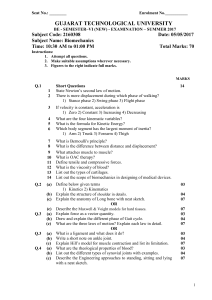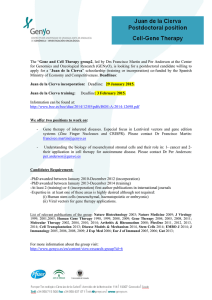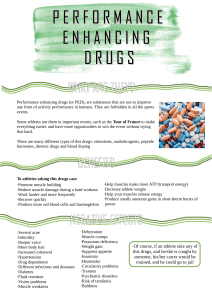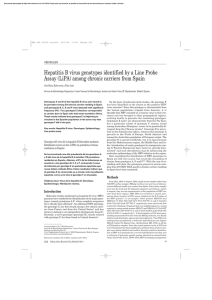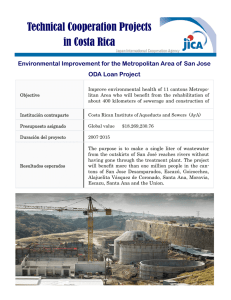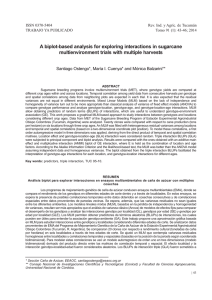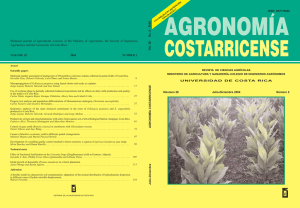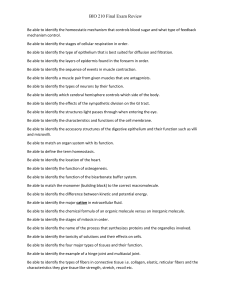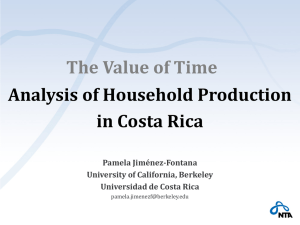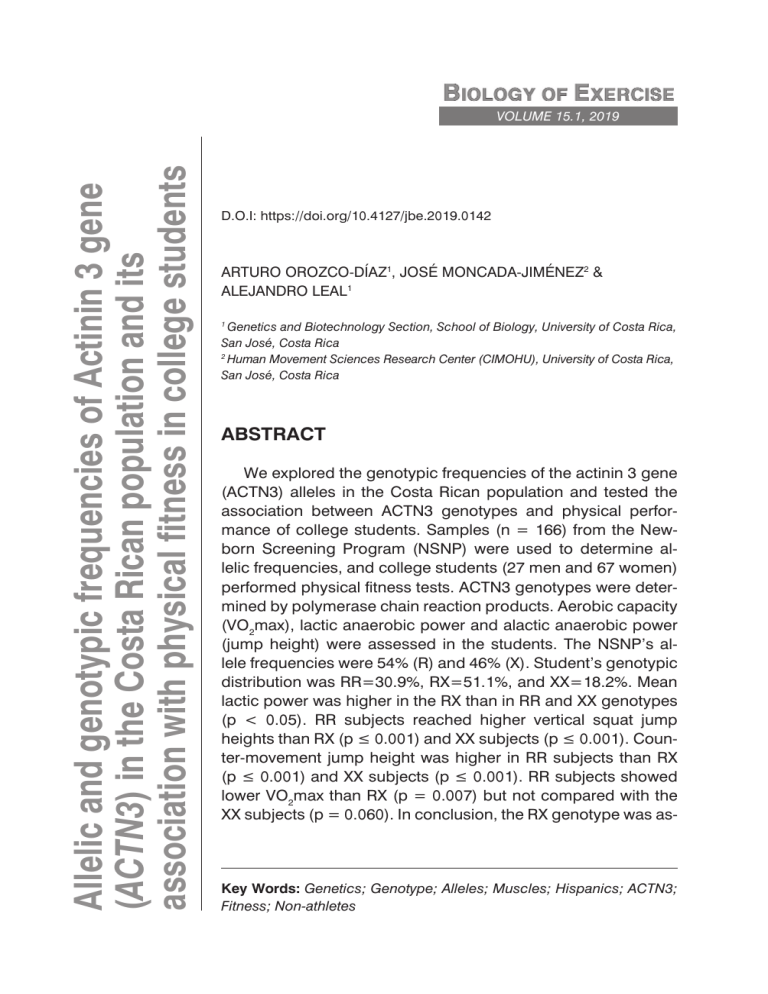
Allelic and genotypic frequencies of Actinin 3 gene (ACTN3) in the Costa Rican population and its association with physical fitness in college students VOLUME 15.1, 2019 D.O.I: https://doi.org/10.4127/jbe.2019.0142 ARTURO OROZCO-DÍAZ1, JOSÉ MONCADA-JIMÉNEZ2 & ALEJANDRO LEAL1 1 Genetics and Biotechnology Section, School of Biology, University of Costa Rica, San José, Costa Rica 2 Human Movement Sciences Research Center (CIMOHU), University of Costa Rica, San José, Costa Rica ABSTRACT We explored the genotypic frequencies of the actinin 3 gene (ACTN3) alleles in the Costa Rican population and tested the association between ACTN3 genotypes and physical performance of college students. Samples (n = 166) from the Newborn Screening Program (NSNP) were used to determine allelic frequencies, and college students (27 men and 67 women) performed physical fitness tests. ACTN3 genotypes were determined by polymerase chain reaction products. Aerobic capacity (VO2max), lactic anaerobic power and alactic anaerobic power (jump height) were assessed in the students. The NSNP’s allele frequencies were 54% (R) and 46% (X). Student’s genotypic distribution was RR=30.9%, RX=51.1%, and XX=18.2%. Mean lactic power was higher in the RX than in RR and XX genotypes (p < 0.05). RR subjects reached higher vertical squat jump heights than RX (p ≤ 0.001) and XX subjects (p ≤ 0.001). Counter-movement jump height was higher in RR subjects than RX (p ≤ 0.001) and XX subjects (p ≤ 0.001). RR subjects showed lower VO2max than RX (p = 0.007) but not compared with the XX subjects (p = 0.060). In conclusion, the RX genotype was as- Key Words: Genetics; Genotype; Alleles; Muscles; Hispanics; ACTN3; Fitness; Non-athletes 2 JBE – VOL. 15.1, 2019 sociated with lactic anaerobic and aerobic capacity and the RR genotype showed association with alactic anaerobic power. INTRODUCTION Abundant evidence demonstrates that skeletal muscle actin-binding protein α-actinin-3 (ACTN3) is related to elite sports performance (14, 30). A non-sense mutation C-T at position 1747 in exon 16 in the ACTN3 gene results in a premature stop codon instead of an arginine at codon 577 (5). Homozygosity of this X allele results in the absence of ACTN3 expression, with no apparent association with muscle disease phenotypes (5). The ACTN3 gene distribution has been described extensively in several athletic African (6; 11), Australian (30), European (11, 18, 22), Asian (13; 27), North-American, Caribbean (26), and South American (23) populations. However, there is a lack of information regarding ACTN3 gene distribution in Central American populations. Approximately 18% of Caucasians are ACTN3 deficient, indicating that the single nucleotide polymorphism (SNP) is a common polymorphism among this group. The mutation does not compromise muscle function, suggesting that the isoform, ACTN2 may compensate for the lack of ACTN3 (21). Meta-analytic evidence, indicates a strong association between ACTN3 and superior power performance (16). Power athletes have a lower X allele frequency than endurance athletes or controls, which may support the influence of the X allele on muscle performance (15). In fact, the ACTN3 isoform is important in activities requiring great speed or power output. In contrast, among endurance athletes the lack ACTN3 is related to better performance in athletic events requiring superior aerobic capacity (21). Although scientific evidence on homogenous genotypes is abundant on athletes, research focusing on heterozygous genotype in non-athletes is scarce. In addition, there are no studies with Central American populations on the ACTN3 gene. Therefore, the aim of the study was twofold. First, the intent was to determine the allelic and genotypic frequencies of the ACTN3 gene in the Costa Rican population, and secondly, to determine the association between ACTN3 gene and physical fitness in non-athlete young university students. MATERIALS AND METHODS Participants Allelic and genotypic frequencies of the ACTN3 gene in the Costa Rican population were determined in 166 unidentified samples from the Newborn Screening ALLELIC AND GENOTYPIC FREQUENCIES OF ACTININ 3 GENE (ACTN3) 3 National Program (NSNP). Volunteers for genetic and physical fitness testing were 94 non-athlete healthy adults (67 females, 27 males), recruited from a sports/physical activity classes at the University of Costa Rica. The Scientific Ethics Committee at the University of Costa Rica approved the study, and written informed consent was obtained from participants. We followed the ethical guidelines set forth by the Declaration of Helsinki. Physical fitness testing This was a cross-sectional analytical study where participants were measured only one time. Participants completed a health-history form, and underwent a graded maximal exercise test (Bruce Protocol) on a treadmill to determine maximal oxygen consumption (VO2max) via respiratory-gas analysis with a Cosmed Quark b2 (Chicago, IL) metabolic cart. The oxygen and carbon dioxide sensors were calibrated using gases with known concentrations before each test. The flow sensors were also calibrated before each test using a 3-L syringe. Termination criteria for the VO2max test were two of the three following: a request to stop the test, RER ≥ 1.15, or a plateau of the VO2 curve < 2 ml·kg-1·min-1 with increased workload (19). Alactic anaerobic capacity was measured by countermovement (CMJ) and squat jump (SJ). For each type of jump, the participants had three opportunities to reach the highest jump. The duration of each jump was collected through a Lafayette contact mat (Lafayette, IN) and converted to cm through a formula: Distance (cm) = (flight duration [seconds]2 x 1.226) × 100 (17). Lactic anaerobic capacity was assessed with the Wingate Anaerobic Test (12) performed on a Lode Excalibur Sport cycle ergometer (Lode B.V., Groningen, The Netherlands). Participants pedaled for 30-s at maximal propelling speed against a resistance of 7.0% of the subject’s body mass. Peak (PP), mean (MP), time to peak power (TPP), and fatigue index (FI) were computed during the test. Genetic analysis Genomic DNA was isolated from peripheral blood (4 mL) using the Phenol Chloroform protocol. PCR analysis was used to amplify the 303 bp fragment containing the mentioned mutation. The primer sequences were CGATCAGTGGGACAACCTG (forward) and CTCCTCCAGAGAGCCAGCTA (reverse). PCR protocol used was 95 °C -5 min., 95 °C- 30 s, 60 °C- 30 s, 72 °C- 30 s (30 cycles) and 72 °C- 10 min (25). ACTN3 genotypes were determined by enzymatic digestion of the PCR products with DdeI. The fragment size expected were 205 and 86 bp for the RR genotype; 108, 97, 86 bp for XX genotype; 205, 108, 97 86 for RX. Fragments were observed on polyacrylamide gels (10%). 4 JBE – VOL. 15.1, 2019 Statistical analysis Data were analyzed with the IBM SPSS software (IBM Corporation, Armonk, New York), version 20. Descriptive statistics included mean ± standard deviation (SD), and gene frequency distribution (%). Factorial 2 x 3 general lineal modelANOVA was performed with ACTN3 and gender as independent variables, and physical performance measures as dependent variables. Statistical significance was set a priori at p ≤ 0.05. RESULTS The ACTN3 gene frequencies in the Costa Rican NSNP sample were 27.10% for RR genotype, 53.6% for RX genotype and 19.2% for XX genotype. The allele frequencies obtained were 54% (R allele) and 46% (X allele). Descriptive statistics for non-athletes participants are shown in Table 1. Consistent to previous studies (3, 21), the prevalence of the different ACTN3 genotypes analyzed in blood samples were not significantly different between gender and genotypes (χ2 = 3.73, p = 0.155). Table 1 Descriptive characteristics of the participants (n = 94) Women (n = 67) Variable Men (n = 27) Mean ± SD Mean ± SD Weight (kg) 58.09 10.92 67.68 11.26 Height (cm) 160.68 7.92 172.58 6.56 VO2max (ml·kg-1·min-1) 30.23 5.86 41.82 9.47 SJ (cm) 28.07 6.28 30.15 8.05 CMJ (cm) 31.54 7.62 33.92 7.86 Mean Power (N) 319.53 87.09 521.11 125.39 Peak Power (N) 529.67 191.96 897.96 252.13 Time to Peak Power (s) 1.45 1.07 1.35 0.64 Fatigue Index (%) 58.45 15.05 65.00 13.44 Note: SJ: squat jump; CMJ: counter-movement jump. 5 ALLELIC AND GENOTYPIC FREQUENCIES OF ACTININ 3 GENE (ACTN3) Significant main effects for gender (p ≤ 0.001) and genotype (p = 0.019) were found on VO2max (Table 2). Post hoc analysis showed higher VO2max in males (42.54 ± 1.42 ml·kg-1·min-1) than females (29.93 ± 0.94 ml·kg-1·min-1) (p ≤ 0.001). The RR participants showed lower VO2max (33.15 ± 1.30 ml·kg-1·min-1) than RX participants (38.11 ± 1.23 ml·kg-1·min-1) (p ≤ 0.001); however, no differences in VO2max were found between RR and XX genotypes (37.44 ± 1.84 ml·kg-1·min-1) (p = 0.060). Table 2 Genotypic frequencies by gender and performance test (n = 94) Men (n = 27) Women (n = 67) Variables RR (n=12) RX (n=10) XX (n=5) RR (n=17) RX (n=38) XX (n=12) Peak power (N) 873.92 ± 337.45 918.34 ± 195.30 912.70 ± 105.72 465.59 ± 169.74 575.16 ± 204.04 476.39 ± 150.16 Mean power (N/30 s) 480.23 ± 173.63 570.69 ± 49.94 520.07 ± 50.06 291.87 ± 67.35 336.94 ± 99.78 303.56 ± 53.98 Fatigue index (%) 72.58 ± 12.46 55.54 ± 11.97 65.71 ± 5.20 53.43 ± 15.27 60.25 ± 14.86 59.88 ± 15.02 Time to peak power (s) 1.09 ± 0.32 1.51 ± 0.67 1.65 ± 0.97 1.11 ± 0.39 1.47 ± 1.23 1.82 ± 1.10 SJ (cm) 36.91 ± 6.58 25.13 ± 2.98 23.91 ± 5.76 33.77 ± 5.73 26.56 ± 5.46 24.75 ± 4.31 CMJ (cm) 39.97 ± 5.14 31.05 ± 4.22 25.13 ± 7.81 37.22 ± 8.52 30.64 ± 6.45 26.29 ± 4.41 VO2max (ml·kg-1·min-1) 37.85 ± 9.23 45.20 ± 7.19 44.56 ± 12.12 28.45 ± 3.97 31.01 ± 6.82 30.30 ± 4.42 Note: SJ: squat jump; CMJ: counter-movement jump. A significant main effect was found for genotype (p ≤ 0.001) on SJ. Regardless of gender, participants with the RR genotype reached higher vertical jump distances (35.34 ± 1.01 cm) compared to those with the RX (25.95 ± 0.95 cm, P ≤ .001) and XX (24.33 ± 1.42 cm, p ≤ 0.001) genotypes. No significant differences were found in jump height between RX and XX subjects (p = 0.380). A significant main effect was found for genotype (p ≤ 0.001) in the CMJ. Re- 6 JBE – VOL. 15.1, 2019 gardless of the gender, RR participants reached higher vertical jump distances (38.599 ± 1.20 cm) than those with RX (30.85 ± 1.13 cm, p ≤ 0.001) and XX (25.71 ± 1.70 cm, p ≤ 0.001) genotypes. Significant differences were also found between RX and XX participants (p = 0.014). Regarding to the performance tests, significant differences in PP generation were obtained between males (901.65 ± 43.39 N) and females (505.71 ± 28.76 N) regardless of the genotype (p ≤ 0.001). Significant main effect gender (p ≤ 0.001) and genotype (p ≤ 0.001) were obtained on MP. Post hoc analysis showed that males had higher MP (523.66 ± 20.12 N) than females (310.79 ± 13.34 N). Participants with the RR genotype showed a significantly lower MP than those with the RX genotype; however, performance in those with the RR genotype was similar to those with the XX genotype (p = 0.420). No significant differences were found on MP between the RX and XX genotypes (p = 0.182). In addition, a significant interaction between gender and genotype was found on FI (p = 0.006) (Figure 1). Simple effect analysis of the interaction revealed that males with RR genotype had higher FI than women. No significant gender differences were found for the RX (p = 0.350) and XX (p = 0.440) genotypes. No significant main effects were found for gender (p = 0.819) and genotype (P = 0.097) on TPP. Fig. 1. Fatigue index in males and females by predominant genotype (a > b, p = 0.001). ALLELIC AND GENOTYPIC FREQUENCIES OF ACTININ 3 GENE (ACTN3) 7 DISCUSSION Genotype frequencies found in this study for the Costa Rican population were different for those reported before in Hispanic populations born or living in the United States (3). Our data shows that the Costa Rican population is more similar to Caucasians regarding to this gene, with an XX genotype frequency of 18% (30). The general population of Costa Rica is a hybrid of genes of European origin (61%), followed by the Amerindian (30%) and a smaller African influence (9%), with a highly similar pattern in the country. The north and central regions show an elevated European ancestry, with the majority of genes fluctuating between 51% and 66% (20). The majority of non-athlete students that participated in the present study are originally from the central and north regions of the country, which is reflected in the allelic frequencies obtained, 56.4% (R allele) and 43.6% (X allele). The participants also have an R allele frequency higher than the general Costa Rican population. The ACTN3 activity that exists when at least one R allele is present (the predominant isoform in fast fibers) confer a higher absorption or force transmission capacity to the Z line during a quick muscular contraction. Approximately 45% of fiber type proportions are due to genetic factors (28). ACTN3 conferred a higher number of fibers, a wider diameter and a stable contraction unit to type II fibers that allow the muscle to generate a bigger power capacity (23). This can explain the results obtained in the present study. The ACTN3 R577X polymorphism causes complete loss of the protein in XX homozygotes. This status has been associated with muscular performance in resistance Australian Elite athletes. In one study, the R allele was more common in power and speed athletes, while the X allele was found more commonly in resistance athletes (3). Based on this evidence, we expected that XX would show significant performance differences to the other phenotypes, but this did not occur. With our study population, only the RX showed significant differences in VO2max in comparison to RR genotype. It is likely that the sample size for XX genotype in this study, prevented the result from reaching statistical significance (p = 0.060). These results are different from previous studies where the R allele showed a dominant effect in the heterozygous genotype (3, 29-30). The ACTN3 protein has an important role in the muscle fiber differentiation towards fast contraction and glycolytic fiber, and the lack of the protein produce a slower and oxidative fiber (4); this is an argument against the R allele dominance, and it could explain our results. The ACTN3 absence in the muscle causes a reduction in the glycogen phosphorylase glycolytic enzyme (GF), this produces a reduction in the capacity to degrade muscle glycogen to obtain energy. The deficiency of α-actinin works against the power and speed activities in athletic populations (30). It has been demon- 8 JBE – VOL. 15.1, 2019 strated that a low GF activity and a high muscular glycogen occur simultaneously with a high glycolytic and mitochondrial enzymes activity KO mice for ACTN3. A reduced ability to access glycogen is detrimental for speed athletes, because they require muscle glycogen as an endogenous fuel to produce energy for muscular contraction. Nevertheless, a reduction in the availability of glucose will result in compensatory switch towards aerobic metabolism. This could be advantageous to resistance athletes, because this could allow them to preserve muscle glycogen and use instead other energy sources such as fatty acids (24). Besides the low GF activity, the lack of ACTN3 produces changes in contractile properties. The KO mice present longer relaxation times, lower force generation, higher fatigue resistance, due to a diameter reduction in type IIb fibers (1). Females have a smaller muscle mass compared to males, and it has been reported that their absolute force is 66% less than that of males (9). Cross-sectional studies indicate that in general, women have absolute maximal force values lower than men. This difference is bigger in upper body (women/men= 0.56) than in the lower body (r = 0.72). It is possible that the bigger size (~10%), weight (~11 kg), muscle mass index, muscle fiber size and base level of testosterone in men could explain partial or totally the reason for men to have a higher force values (8). This is in agreement with Norman et al. (2009), and our results on the lactic anaerobic test, since PP, MP and FI showed gender differences; however, no association between the genotype and the PP performance was observed in our study, possibly because the physical test used to measure power has a resistance measure component as well. In addition, we found an association between the heterozygous (RX) genotype and the Wingate Test results (p = 0.030) in agreement with our hypothesis that RR and RX subjects will have a better physical performance than XX subjects. Wingate test is an anaerobic test that measures lactic power capacity, and involves power generation, as well as resistance and fatigue to peak power (10). To our knowledge this is the first study to report significant performance differences for the heterozygous genotype using Wingate. The physiological, metabolic and genetic mechanism that can explain the results of the heterozygous genotype in anaerobic performance measures are unknown. However, it is possible that during muscle contraction of individuals with this genotype some muscle fibers could be acting as power fibers, while others could be acting as resistance fibers. This would allow the muscle to produce power, albeit not as high as in the RR genotype, and also hold the contraction for a longer period of time. However, the interaction level between these two alleles is unknown, and there may be another gene or metabolic pathway influencing this genotype that we are currently unaware of. The capacity to generate high power values and to sustain them for very short periods of time is known as the fatigue index, which represents a muscular mechanism that protects muscle fibers from damage caused by high muscle contraction ALLELIC AND GENOTYPIC FREQUENCIES OF ACTININ 3 GENE (ACTN3) 9 force generation (7). In the present study, significant differences between men and women (p = 0.006) were observed. A higher power generation could be explained by men having bigger capacity to generate force (10). In the present study, RR men and women reached a higher vertical jump in both jumps (SJ, CMJ). This test measures the force generated by the lower body in a single explosive jump (extremely fast muscular contraction). This result agrees with the one reported by Yang et al. (2003) that proves that R allele provides an advantage for speed and power activities. Indeed, Vincent et al. (2007), concluded that young men with the RR genotype have dynamic quadriceps torques, relatively higher to 300°/s, and a higher % of type II fibers than those with XX genotype. In contrast with the present study, others have failed to show that the R577X polymorphism is associated with the production of explosive power on young nonathletes, reported through height reach in vertical jumps (25). The inconsistencies between studies could be explained by differences in the physical tests used to characterized muscular power phenotype. The majority of jump or speed actions that are naturally performed by humans are multi articular movements, which involve high angular velocities and the coordinated lower body muscles (2). Most of the previous studies looking at non-athletes focus on one single articulation movements at low angular velocities (≤ 300°/s) (25). Allele frequencies obtained in our NBSP, showed that, although Costa Rica is a hybrid population, the frequency of this gene is more likely similar to the one reported for Caucasians. We found evidence that the presence of the R allele of the ACTN3 gene influences positively the ability to generate a major explosive lower body power (anaerobic alactic capacity) in young, non-athlete students, independently of gender. An association was also found between the RX genotype and the MP variable in the Wingate Test (anaerobic lactic capacity). No association between the XX genotype and VO2max good performance (aerobic capacity) was found, but we did find an association between this variable and the RX genotype. These observations confer to the heterozygous a particular phenotypic entity that should be further studied. CONCLUSION Our results confirm that ACTN3 influences skeletal muscle metabolic function, and that its presence is important for power and force generation. This study also confirms that the ACTN3 genotype influences the physical performance even in untrained young people, and that the heterozygous constitutes a different performance category than the homozygous. These facts should be extensively studied, in particularly in relationship with sport training variations, depending on the genetic background. Finally, the implications of the three different genotypes to the 10 JBE – VOL. 15.1, 2019 different sport disciplines should be addressed, in particular for sports that have both power and resistance components. REFERENCES 1. Berman Y, & North KN. A gene for speed: the emerging role of alpha-actinin-3 in muscle metabolism. Physiology (Bethesda) 25(4): 250-259, 2010. 2. Brown LE, & Weir JP. ASEP Procedures Recommendation I: Accurate assessment of muscular strength and power. JEPOnline 4(3): 1-21, 2001. 3. Clarkson PM, Devaney JM, Gordish-Dressman H, Thompson PD, Hubal MJ, Urso M, ... Hoffman EP. ACTN3 genotype is associated with increases in muscle strength in response to resistance training in women. J Appl Physiol (1985) 99(1): 154-163, 2005. 4. Chan S, Seto JT, MacArthur DG, Yang N, North KN, & Head SI. A gene for speed: contractile properties of isolated whole EDL muscle from an alphaactinin-3 knockout mouse. Am J Physiol Cell Physiol 295(4): C897-904, 2008. 5. Delmonico MJ, Kostek MC, Doldo NA, Hand BD, Walsh S, Conway JM, . . . Hurley BF. Alpha-actinin-3 (ACTN3) R577X polymorphism influences knee extensor peak power response to strength training in older men and women. J Gerontol A Biol Sci Med Sci 62(2): 206-212, 2007. 6. Eynon N, Duarte JA, Oliveira J, Sagiv M, Yamin C, Meckel Y, & Goldhammer E. ACTN3 R577X polymorphism and Israeli top-level athletes. Int J Sports Med 30(9): 695-698, 2009. 7. Fridén J, & Lieber RL. Eccentric exercise-induced injuries to contractile and cytoskeletal muscle fibre components. Acta Physiol Scand 171(3): 321-326, 2001. 8. González-Badillo JJ, & Gorostiaga E. Fundamentals of strength training: Application to high sports performance. Spain: INDE, 2002. 9. Haff GG, & Triplett NT. Essentials of Strength Training and Conditioning. Champaign, IL: Human kinetics, 2015. 10. Heck H, Schulz H, & Bartmus U. Diagnostics of anaerobic power and capacity. Eur J Sport Sci 3(3): 1-23, 2003. 11. Heffernan SM, Kilduff LP, Erskine RM, Day SH, McPhee JS, McMahon GE, . . . Williams AG. Association of ACTN3 R577X but not ACE I/D gene variants with elite rugby union player status and playing position. Physiol Genomics 48(3): 196-201, 2016. 12. Inbar O, Bar-Or O, & Skinner JS. The Wingate anaerobic test. Champaign, IL: Human Kinetics, 1996. 13. Kikuchi N, Nakazato K, Min SK, Ueda D, & Igawa S. The ACTN3 R577X polymorphism is associated with muscle power in male Japanese athletes. J Strength Cond Res 28(7): 1783-1789, 2014. ALLELIC AND GENOTYPIC FREQUENCIES OF ACTININ 3 GENE (ACTN3) 11 14. Lee FX, Houweling PJ, North KN, & Quinlan KG. How does alpha-actinin-3 deficiency alter muscle function? Mechanistic insights into ACTN3, the ‘gene for speed’. Biochim Biophys Acta 1863(4): 686-693, 2016. 15. Loos RJ, Hagberg JM, Perusse L, Roth SM, Sarzynski MA, Wolfarth B, ... Bouchard C. Advances in exercise, fitness, and performance genomics in 2014. Med Sci Sports Exerc 47(6): 1105-1112, 2015. 16. Ma F, Yang Y, Li X, Zhou F, Gao C, Li M, & Gao L. The association of sport performance with ACE and ACTN3 genetic polymorphisms: a systematic review and meta-analysis. PloS One 8(1): e54685, 2013. 17. MacDougall JD, Wenger HA, & Green HJ. Physiological testing of the highperformance athlete. Champaign, IL: Human Kinetics, 1990. 18. Massidda M, Corrias L, Ibba G, Scorcu M, Vona G, & Calo CM. Genetic markers and explosive leg-muscle strength in elite Italian soccer players. J Sports Med Phys Fitness 52(3): 328-334, 2012. 19. Moncada-Jiménez J, Grandjean AJ, Alhassan S, & Grandjean PW. Cardiorespiratory responses to continuously-graded and ramp treadmill protocols. Int J Sports Sci 5(2): 80-86, 2015. 20. Morera B, Barrantes R, & Marin-Rojas R. Gene Admixture in the Costa Rican Population. Ann Hum Genet 67(1): 71-80, 2003. 21. Norman B, Esbjornsson M, Rundqvist H, Osterlund T, von Walden F, & Tesch PA. Strength, power, fiber types, and mRNA expression in trained men and women with different ACTN3 R577X genotypes. J Appl Physiol (1985) 106(3): 959-965, 2009. 22. Pimenta EM, Coelho DB, Cruz IR, Morandi RF, Veneroso CE, de Azambuja Pussieldi G, ... De Paz Fernandez JA. The ACTN3 genotype in soccer players in response to acute eccentric training. Eur J Appl Physiol 112(4): 1495-1503, 2012. 23. Pimenta EM, Coelho DB, Veneroso CE, Barros Coelho EJ, Cruz IR, Morandi RF, ... De Paz Fernandez JA. Effect of ACTN3 gene on strength and endurance in soccer players. J Strength Cond Res 27(12): 3286-3292, 2013. 24. Quinlan KG, Seto JT, Turner N, Vandebrouck A, Floetenmeyer M, Macarthur DG, ... North KN. Alpha-actinin-3 deficiency results in reduced glycogen phosphorylase activity and altered calcium handling in skeletal muscle. Hum Mol Genet 19(7): 1335-1346, 2010. 25. Santiago C, Rodriguez-Romo G, Gomez-Gallego F, Gonzalez-Freire M, Yvert T, Verde Z, . . . Lucia A. Is there an association between ACTN3 R577X polymorphism and muscle power phenotypes in young, non-athletic adults? Scand J Med Sci Sports 20(5): 771-778, 2010. 26. Scott RA, Irving R, Irwin L, Morrison E, Charlton V, Austin K, ... Pitsiladis YP. ACTN3 and ACE genotypes in elite Jamaican and US sprinters. Med Sci Sports Exerc 42(1): 107-112, 2010. 12 JBE – VOL. 15.1, 2019 27. Shang X, Huang C, Chang Q, Zhang L, & Huang T. Association between the ACTN3 R577X polymorphism and female endurance athletes in China. Int J Sports Med 31(12): 913-916, 2010. 28. Simoneau JA, & Bouchard C. Genetic determinism of fiber type proportion in human skeletal muscle. FASEB J 9(11): 1091-1095, 1995. 29. Vincent B, De Bock K, Ramaekers M, Van den Eede E, Van Leemputte M, Hespel P, & Thomis MA. ACTN3 (R577X) genotype is associated with fiber type distribution. Physiol Genomics 32(1): 58-63, 2007. 30. Yang N, MacArthur DG, Gulbin JP, Hahn AG, Beggs AH, Easteal S, & North K. ACTN3 genotype is associated with human elite athletic performance. Am J Hum Genet 73(3): 627-631, 2003. Address for correspondence: Dr. José Moncada-Jiménez, Human Movement Sciences Research Center, University of Costa Rica, P.O. Box 239-1200, Pavas, San José, Costa Rica. E-mail: [email protected]
